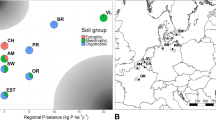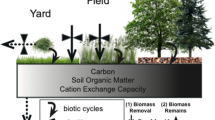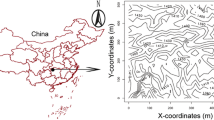Abstract
Over the past several decades, the conversion of native forest to agricultural land uses has accelerated across the Amazon Basin. Despite a growing body of research on nutrient dynamics in Amazonian primary forest and forest-derived land uses, the effects of widespread land-use change on nutrient contents and cycles in soil and vegetation are not well understood. We reviewed over 100 studies conducted in Amazônia over the past 40 years on nutrient dynamics in natural forests and forest-derived land uses (pasture, shifting cultivation, and tree plantations). Our objectives were to compare soil data from land uses across Amazônia and identify any gaps in our present knowledge that might offer direction for future research. Specifically, by analyzing data we tested the following five widely cited hypotheses concerning the effects of land-use change on soil properties compiled from 39 studies in multifactorial ANOVA models; (a) soil pH, effective cation exchange capacity (ECEC), and exchangeable calcium (Ca) concentrations rise and remain elevated following the slash-and-burn conversion of forest to pasture or crop fields; (b) soil contents of total carbon (C), nitrogen (N), and inorganic readily extractable (that is, Bray, Mehlich I, or resin) phosphorus (Pi) decline following forest-to-pasture conversion; (c) soil concentrations of total C, N, and Pi increase in secondary forests with time since abandonment of agricultural activities; (d) soil nutrient conditions under all tree-dominated land-use systems (natural or not) remain the same; and (e) higher efficiencies of nutrient utilization occur where soil nutrient pools are lower. Following the conversion of Amazonian forest to pasture or slash-and-burn agriculture, we found a significant and lasting effect on soil pH, bulk density, and exchangeable Ca concentrations. Unlike the other three land uses studied, concentrations of extractable soil Pi were equally low in both forest and pastures of all age classes, which demonstrates that postburning pulses in soil Pi concentration following a slash-and-burn decrease rapidly after forest-to-pasture conversion, perhaps due to accumulation in organic P fractions. Neither the concentrations nor the contents of total C and N appeared to change greatly on a regionwide basis as a result of forest-to-pasture conversion, but surface soil C:N ratios in 5-year-old pastures were significantly higher than those in older pastures, suggesting changes in the soil concentrations of at least one of these elements with time after pasture creation. Pasture soils did have higher total C and N concentrations than land uses such as annual cropping and secondary forest fallow, indicating that soil C and N maintenance and/or accumulation following forest conversion may be greater in pastures than in these other two land uses. The low concentrations of C and N in shifting cultivation soils appear to persist for many years in secondary forests regenerating from abandoned crop fields, suggesting that the recuperation of soil losses of C and N resulting during no-input annual cropping is slower than previously thought. Soil C, N and P concentrations were strongly related to clay content. Across all land uses, efficiencies of N, P, and Ca use (estimated as the inverse of litterfall N, P, and Ca contents) were not related to the sizes of their soil pools. More work is needed to test and standardize P extraction procedures that more accurately reflect plant availability. Few studies have been conducted to determine the role of organic P fractions and dissolved organic N (DON) in the elemental cycles of both natural and managed systems in this region. In general, we recommend further study of annual and perennial cropping systems, as well as more detailed examination of managed pastures and fallows, and secondary forests originating from various disturbances, since the intensity of previous land use likely determines the degree of soil degradation and the rate of subsequent secondary regrowth.
Similar content being viewed by others
Author information
Authors and Affiliations
Additional information
Received 2 August 2000; accepted 14 May 2001.
Rights and permissions
About this article
Cite this article
McGrath, D., Smith, C., Gholz, H. et al. Effects of Land-Use Change on Soil Nutrient Dynamics in Amazônia. Ecosystems 4, 625–645 (2001). https://doi.org/10.1007/s10021-001-0033-0
Issue Date:
DOI: https://doi.org/10.1007/s10021-001-0033-0




